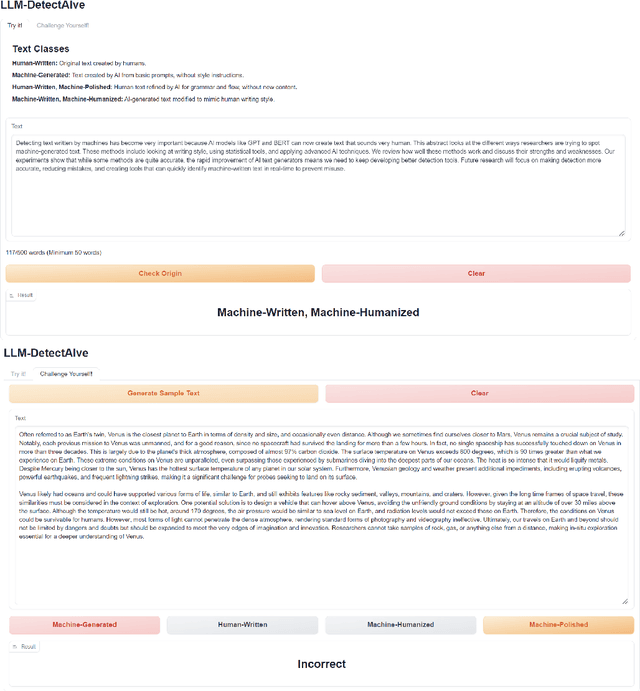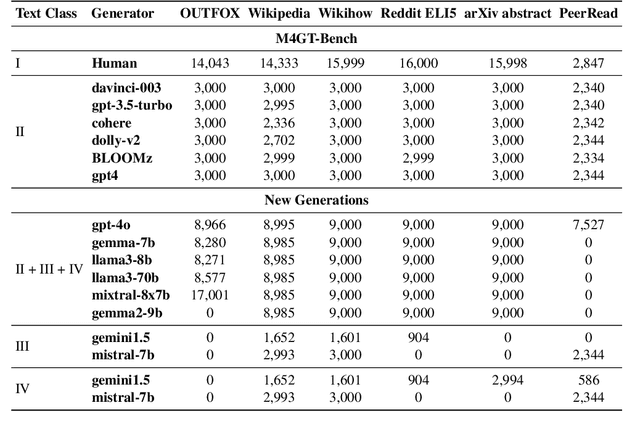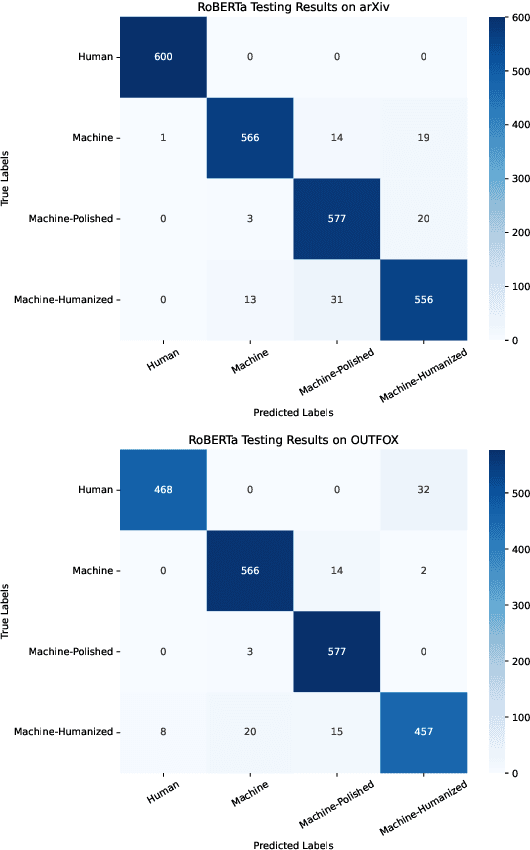Zhuohan Xie
FRaN-X: FRaming and Narratives-eXplorer
Jul 09, 2025Abstract:We present FRaN-X, a Framing and Narratives Explorer that automatically detects entity mentions and classifies their narrative roles directly from raw text. FRaN-X comprises a two-stage system that combines sequence labeling with fine-grained role classification to reveal how entities are portrayed as protagonists, antagonists, or innocents, using a unique taxonomy of 22 fine-grained roles nested under these three main categories. The system supports five languages (Bulgarian, English, Hindi, Russian, and Portuguese) and two domains (the Russia-Ukraine Conflict and Climate Change). It provides an interactive web interface for media analysts to explore and compare framing across different sources, tackling the challenge of automatically detecting and labeling how entities are framed. Our system allows end users to focus on a single article as well as analyze up to four articles simultaneously. We provide aggregate level analysis including an intuitive graph visualization that highlights the narrative a group of articles are pushing. Our system includes a search feature for users to look up entities of interest, along with a timeline view that allows analysts to track an entity's role transitions across different contexts within the article. The FRaN-X system and the trained models are licensed under an MIT License. FRaN-X is publicly accessible at https://fran-x.streamlit.app/ and a video demonstration is available at https://youtu.be/VZVi-1B6yYk.
VSCBench: Bridging the Gap in Vision-Language Model Safety Calibration
May 26, 2025Abstract:The rapid advancement of vision-language models (VLMs) has brought a lot of attention to their safety alignment. However, existing methods have primarily focused on model undersafety, where the model responds to hazardous queries, while neglecting oversafety, where the model refuses to answer safe queries. In this paper, we introduce the concept of $\textit{safety calibration}$, which systematically addresses both undersafety and oversafety. Specifically, we present $\textbf{VSCBench}$, a novel dataset of 3,600 image-text pairs that are visually or textually similar but differ in terms of safety, which is designed to evaluate safety calibration across image-centric and text-centric scenarios. Based on our benchmark, we evaluate safety calibration across eleven widely used VLMs. Our extensive experiments revealed major issues with both undersafety and oversafety. We further investigated four approaches to improve the model's safety calibration. We found that even though some methods effectively calibrated the models' safety problems, these methods also lead to the degradation of models' utility. This trade-off underscores the urgent need for advanced calibration methods, and our benchmark provides a valuable tool for evaluating future approaches. Our code and data are available at https://github.com/jiahuigeng/VSCBench.git.
LLM-BABYBENCH: Understanding and Evaluating Grounded Planning and Reasoning in LLMs
May 17, 2025Abstract:Assessing the capacity of Large Language Models (LLMs) to plan and reason within the constraints of interactive environments is crucial for developing capable AI agents. We introduce $\textbf{LLM-BabyBench}$, a new benchmark suite designed specifically for this purpose. Built upon a textual adaptation of the procedurally generated BabyAI grid world, this suite evaluates LLMs on three fundamental aspects of grounded intelligence: (1) predicting the consequences of actions on the environment state ($\textbf{Predict}$ task), (2) generating sequences of low-level actions to achieve specified objectives ($\textbf{Plan}$ task), and (3) decomposing high-level instructions into coherent subgoal sequences ($\textbf{Decompose}$ task). We detail the methodology for generating the three corresponding datasets ($\texttt{LLM-BabyBench-Predict}$, $\texttt{-Plan}$, $\texttt{-Decompose}$) by extracting structured information from an expert agent operating within the text-based environment. Furthermore, we provide a standardized evaluation harness and metrics, including environment interaction for validating generated plans, to facilitate reproducible assessment of diverse LLMs. Initial baseline results highlight the challenges posed by these grounded reasoning tasks. The benchmark suite, datasets, data generation code, and evaluation code are made publicly available ($\href{https://github.com/choukrani/llm-babybench}{\text{GitHub}}$, $\href{https://huggingface.co/datasets/salem-mbzuai/LLM-BabyBench}{\text{HuggingFace}}$).
A Head to Predict and a Head to Question: Pre-trained Uncertainty Quantification Heads for Hallucination Detection in LLM Outputs
May 13, 2025Abstract:Large Language Models (LLMs) have the tendency to hallucinate, i.e., to sporadically generate false or fabricated information. This presents a major challenge, as hallucinations often appear highly convincing and users generally lack the tools to detect them. Uncertainty quantification (UQ) provides a framework for assessing the reliability of model outputs, aiding in the identification of potential hallucinations. In this work, we introduce pre-trained UQ heads: supervised auxiliary modules for LLMs that substantially enhance their ability to capture uncertainty compared to unsupervised UQ methods. Their strong performance stems from the powerful Transformer architecture in their design and informative features derived from LLM attention maps. Experimental evaluation shows that these heads are highly robust and achieve state-of-the-art performance in claim-level hallucination detection across both in-domain and out-of-domain prompts. Moreover, these modules demonstrate strong generalization to languages they were not explicitly trained on. We pre-train a collection of UQ heads for popular LLM series, including Mistral, Llama, and Gemma 2. We publicly release both the code and the pre-trained heads.
Llama-3.1-Sherkala-8B-Chat: An Open Large Language Model for Kazakh
Mar 03, 2025Abstract:Llama-3.1-Sherkala-8B-Chat, or Sherkala-Chat (8B) for short, is a state-of-the-art instruction-tuned open generative large language model (LLM) designed for Kazakh. Sherkala-Chat (8B) aims to enhance the inclusivity of LLM advancements for Kazakh speakers. Adapted from the LLaMA-3.1-8B model, Sherkala-Chat (8B) is trained on 45.3B tokens across Kazakh, English, Russian, and Turkish. With 8 billion parameters, it demonstrates strong knowledge and reasoning abilities in Kazakh, significantly outperforming existing open Kazakh and multilingual models of similar scale while achieving competitive performance in English. We release Sherkala-Chat (8B) as an open-weight instruction-tuned model and provide a detailed overview of its training, fine-tuning, safety alignment, and evaluation, aiming to advance research and support diverse real-world applications.
Entity Framing and Role Portrayal in the News
Feb 20, 2025Abstract:We introduce a novel multilingual hierarchical corpus annotated for entity framing and role portrayal in news articles. The dataset uses a unique taxonomy inspired by storytelling elements, comprising 22 fine-grained roles, or archetypes, nested within three main categories: protagonist, antagonist, and innocent. Each archetype is carefully defined, capturing nuanced portrayals of entities such as guardian, martyr, and underdog for protagonists; tyrant, deceiver, and bigot for antagonists; and victim, scapegoat, and exploited for innocents. The dataset includes 1,378 recent news articles in five languages (Bulgarian, English, Hindi, European Portuguese, and Russian) focusing on two critical domains of global significance: the Ukraine-Russia War and Climate Change. Over 5,800 entity mentions have been annotated with role labels. This dataset serves as a valuable resource for research into role portrayal and has broader implications for news analysis. We describe the characteristics of the dataset and the annotation process, and we report evaluation results on fine-tuned state-of-the-art multilingual transformers and hierarchical zero-shot learning using LLMs at the level of a document, a paragraph, and a sentence.
KazMMLU: Evaluating Language Models on Kazakh, Russian, and Regional Knowledge of Kazakhstan
Feb 18, 2025



Abstract:Despite having a population of twenty million, Kazakhstan's culture and language remain underrepresented in the field of natural language processing. Although large language models (LLMs) continue to advance worldwide, progress in Kazakh language has been limited, as seen in the scarcity of dedicated models and benchmark evaluations. To address this gap, we introduce KazMMLU, the first MMLU-style dataset specifically designed for Kazakh language. KazMMLU comprises 23,000 questions that cover various educational levels, including STEM, humanities, and social sciences, sourced from authentic educational materials and manually validated by native speakers and educators. The dataset includes 10,969 Kazakh questions and 12,031 Russian questions, reflecting Kazakhstan's bilingual education system and rich local context. Our evaluation of several state-of-the-art multilingual models (Llama-3.1, Qwen-2.5, GPT-4, and DeepSeek V3) demonstrates substantial room for improvement, as even the best-performing models struggle to achieve competitive performance in Kazakh and Russian. These findings underscore significant performance gaps compared to high-resource languages. We hope that our dataset will enable further research and development of Kazakh-centric LLMs. Data and code will be made available upon acceptance.
Is Human-Like Text Liked by Humans? Multilingual Human Detection and Preference Against AI
Feb 17, 2025Abstract:Prior studies have shown that distinguishing text generated by large language models (LLMs) from human-written one is highly challenging, and often no better than random guessing. To verify the generalizability of this finding across languages and domains, we perform an extensive case study to identify the upper bound of human detection accuracy. Across 16 datasets covering 9 languages and 9 domains, 19 annotators achieved an average detection accuracy of 87.6%, thus challenging previous conclusions. We find that major gaps between human and machine text lie in concreteness, cultural nuances, and diversity. Prompting by explicitly explaining the distinctions in the prompts can partially bridge the gaps in over 50% of the cases. However, we also find that humans do not always prefer human-written text, particularly when they cannot clearly identify its source.
GenAI Content Detection Task 1: English and Multilingual Machine-Generated Text Detection: AI vs. Human
Jan 19, 2025Abstract:We present the GenAI Content Detection Task~1 -- a shared task on binary machine generated text detection, conducted as a part of the GenAI workshop at COLING 2025. The task consists of two subtasks: Monolingual (English) and Multilingual. The shared task attracted many participants: 36 teams made official submissions to the Monolingual subtask during the test phase and 26 teams -- to the Multilingual. We provide a comprehensive overview of the data, a summary of the results -- including system rankings and performance scores -- detailed descriptions of the participating systems, and an in-depth analysis of submissions. https://github.com/mbzuai-nlp/COLING-2025-Workshop-on-MGT-Detection-Task1
LLM-DetectAIve: a Tool for Fine-Grained Machine-Generated Text Detection
Aug 08, 2024



Abstract:The widespread accessibility of large language models (LLMs) to the general public has significantly amplified the dissemination of machine-generated texts (MGTs). Advancements in prompt manipulation have exacerbated the difficulty in discerning the origin of a text (human-authored vs machinegenerated). This raises concerns regarding the potential misuse of MGTs, particularly within educational and academic domains. In this paper, we present $\textbf{LLM-DetectAIve}$ -- a system designed for fine-grained MGT detection. It is able to classify texts into four categories: human-written, machine-generated, machine-written machine-humanized, and human-written machine-polished. Contrary to previous MGT detectors that perform binary classification, introducing two additional categories in LLM-DetectiAIve offers insights into the varying degrees of LLM intervention during the text creation. This might be useful in some domains like education, where any LLM intervention is usually prohibited. Experiments show that LLM-DetectAIve can effectively identify the authorship of textual content, proving its usefulness in enhancing integrity in education, academia, and other domains. LLM-DetectAIve is publicly accessible at https://huggingface.co/spaces/raj-tomar001/MGT-New. The video describing our system is available at https://youtu.be/E8eT_bE7k8c.
 Add to Chrome
Add to Chrome Add to Firefox
Add to Firefox Add to Edge
Add to Edge